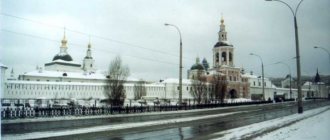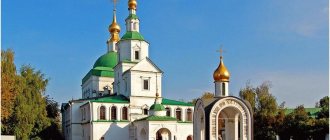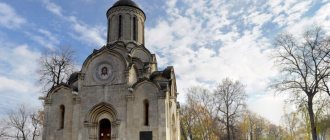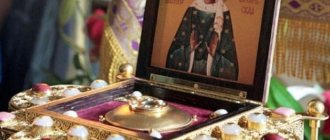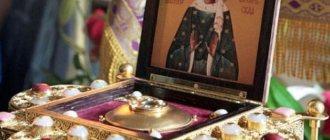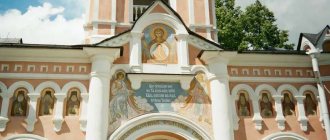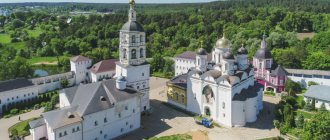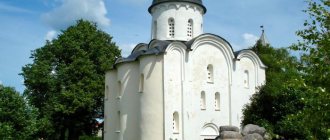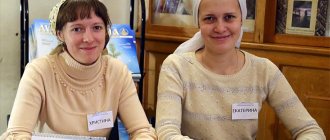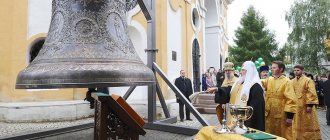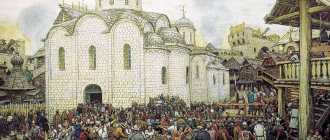St. Daniel's Monastery is one of the pearls in the crown of Christian monasteries in Russia, its structure reminiscent of a Kremlin, which has the status of a stauropegy. Stavropegic monasteries are under the direct leadership of the Patriarch of All Rus'.
The grandeur of the snow-white buildings with green-golden domes captivates at first sight; you can feel peace, tranquility, and grace in them. This is a completely different world, free from vanity and worldly pleasures; only within the walls of God’s cathedrals can you be left alone with God.
Where is the Danilovsky Monastery located in Moscow?
Its location can be defined as the historical center of the capital, but Red Square from here is a full 5 km to the south.
Address
The monastery is located on Danilovsky Val Street, 22.
How to get there
Traditionally, the fastest mode of transport in a metropolis is the metro. This is the easiest way to get to the monastery from any district of the capital. In addition, there are bus and tram stops relatively close to its walls.
Nearest metro station
There are no stations directly next to the monastery: the nearest, Tulskaya, is almost a kilometer away.
Walking from it, the easiest way to get there is through the park, where the chapel of St. Daniel. Then you should go out onto Danilovsky Val Street and turn right.
From Shabolovskaya and Serpukhovskaya you will have to walk twice as far. Those who are in a hurry to attend a service can use other modes of transport in addition to the metro.
View of the Danilov Monastery from the street
Tram, bus
From Tulskaya, passing through the park, you can go to the tram stop No. 3 “Serpukhovskaya Zastava”. The next station is called: “St. Danilov Monastery”. Trams 39 and 26 also go there. The same trams will take the pilgrim from the Shabolovskaya metro station, as well as from the Paveletsky station - this is where Aeroexpress trains arrive from Domodedovo airport.
Buses run from Serpukhovskaya station - routes t71, 41, 700.
Official website of the Danilov Monastery
https://msdm.ru/
Address
Moscow, st. Danilovsky Val, 22 +7
Among the abbots who headed the Danilov brethren in the 19th century, the figure of Archimandrite Amphilochius of Kazan-Sergievsky undoubtedly stands out - he is a very educated man who communicated on equal terms with outstanding representatives of Russian humanities of that time. The hunt for antiquities, respect and love for archeology was instilled in the future father Amphilochius by his good friend - Count Uvarov, Minister of Public Education under Nicholas I and one of the founders of Russian archeology.
The events of the Napoleonic invasion did not bypass the Danilovsky Monastery, but nevertheless it did not suffer very much - the buildings remained intact, the sacristy and treasury were taken to Vologda.
In the 20s of the 20th century, the Danilovsky Monastery played a huge role in the church life of Moscow. The rector of the monastery was Bishop Fedor Pozdeevsky - a brilliant personality, in the past - the rector of the Moscow Theological Academy, expelled from the academy by liberal-minded professors and students in May 1917. Having come into conflict with the professors, he was forced to leave the academy and settled here with the blessing of Patriarch Tikhon, who appointed him Danilov’s rector.
Schedule of services
Here the monastic rules of worship are strictly adhered to.
- Worship services begin very early. From 6 a.m. a midnight office with a fraternal prayer service is served.
- 7 o’clock – liturgy.
- Evening services are held from 5 p.m.
And only on holidays, Sundays, the liturgy begins at 8.45 am. There is also the practice of celebrating two liturgies on holidays - early and late. You can find out what the schedule will be on the monastery’s website.
How to submit a claim
It can be done:
- immediately before the start of the service, or better yet, the night before;
- on the monastery website (section “Order requests”).
If you want to serve a prayer service to one of the saints, or to the venerable founder of the monastery, the schedule of such prayer services, called “custom” ones, can also be found on the website.
View from the porch of the Church of the Holy Fathers of the Seven Ecumenical Councils to the central square of the monastery
History of the holy monastery
It dates back more than 700 years. Danilov is older than the famous Trinity-Sergius Lavra, but, unlike it, he knew several periods when monastic life here was interrupted for a very long time.
Base
It dates back to the times when Moscow was a very small town. This is a small principality of the sons of the blgv. Alexander Nevsky was handed over to his younger brother, Daniil. His life tells that, despite the fact that Moscow was considered a small acquisition, Daniil Alexandrovich humbly accepted the reign, without being offended by his brothers. From his youth he was distinguished by meekness, as if he had a monastic mental disposition.
So, once in Moscow, he apparently almost immediately decided to build a monastery, where he later hoped to take monastic vows himself.
The monastery received the name of the heavenly patron saint of the founder, St. Daniel the Stylite, and the year of its foundation is considered to be 1282.
It was a rather modest monastery, with a wooden church of St. Daniel, several cells of monks. Nevertheless, the prince attached great importance to it, for example, he established that the abbot must necessarily bear the rank of archimandrite.
Peaceful monastic life continued for just over a decade: in 1293, the Mongol commander Tudan completely destroyed several cities in North-Eastern Russia, including Moscow. Of course, a small monastery became easy prey for the enemies, which had to be restored almost from scratch.
Interesting fact
Another 10 years later, on March 17, 1303, the noble prince, feeling the approach of death, took monastic vows without changing his name, in honor of the Prophet Daniel. The custom of taking tonsure on his deathbed was generally accepted for princely families, however, Daniel, obviously, had been seriously taking this step for a long time: he strictly bequeathed not to bury him in the temple, as befitted, given his princely status, but in a brotherly cemetery, as a simple monk
The humble monk was buried according to his will.
Read in detail:
The very first and main owner of the capital is Daniil of Moscow
Under Ivan Kalita
There is very little data about the life of the monks of the next three decades. But in 1330 they had to endure a shock: the son of the founder, Ivan Kalita, transferred the monastery directly to the Kremlin. Now he was called Spassky.
Subsequently, 160 years later, under Ivan III, the brethren were transferred again, to Krutitsky Hill. This is how the Novo-Spassky Monastery arose.
In the same place there remained a church, which became a parish, and a brotherly cemetery, which was increasingly falling into disrepair. For more than two centuries, the grave of Prince Daniel was also left without proper care.
Temple of the Holy Fathers of the Seven Ecumenical Councils. XVI century. Fragment of an engraving by Picard. Late 17th - early 18th century
Years of "timelessness"
However, the Lord was not willing to allow the final oblivion of the saint’s memory. At the place where the monastery was founded, several apparitions of the holy prince are known:
- under Ivan III ; One day the Grand Duke and his retinue were driving past the former monastery; unexpectedly, a certain “unknown man” appeared to one of those close to him, who called himself “a Christian and the master of this place,” and ordered the prince to convey the following accusatory words: “You are comforting yourself, but you have forgotten me, but God has not forgotten me!” ; Prince Ivan, realizing that Daniel himself had appeared to him, ordered from that time on to regularly serve memorial services for him and his other ancestors; however, the miracle did not persuade him to begin rebuilding the monastery;
- under the son of Ivan III, Vasily , a second miracle happened, now with the boyar Shuisky, ; he also happened to end up in the former monastery cemetery, and when leaving, he tried to climb onto a horse, leaning on one of the gravestones; the prince heard a voice commanding “not to dare” to do this, for here is the resting place of Prince Daniel; “You never know how many princes lie here!” - Shuisky answered boldly and immediately flew from his horse to the ground; Shocked, for the rest of his life he deeply revered St. Daniel.
Under Ivan the Terrible
The third miracle of the holy prince happened with this descendant of his - already the ninth generation. By that time, the veneration of St. Daniil was already very common among Muscovites. So, one of the merchants, sailing along the river past the Danilovskaya Church with his sick young son, without any doubt, brought the sick prince to the grave, even laying him directly on the gravestone, believing: the saint would help. After the prayer service, the youth actually stood up completely healthy.
Revival of the Danilov Monastery
Tsar Ivan IV himself and his spiritual father, Metropolitan Macarius . Apparently, it was on the initiative of the saint that the restoration of the monastery began, and moreover, its elevation.
Interesting fact
The first seven-altar stone church in the history of Danilov that appeared here of the Holy Fathers of the Seven Ecumenical Councils should, according to St.
Makaria, to become the spiritual center of the capital. On May 18, 1561 it was consecrated. Since then, every year on this day a host of bishops and priests served the liturgy here in the presence of the sovereign. Then a memorial service was also held for the founder of the monastery.
Time of Troubles
Even under Ivan IV, Danilov received stone walls, becoming an impregnable fortress on the southern approaches to the capital. When at the beginning of the 17th century. the royal dynasty was interrupted, and either Crimean Tatars, or rebellious Cossacks, or Polish invaders began to come to the walls of Moscow; the monks had to endure many attacks:
- in 1591 - the Crimean Khan; after a stubborn battle, the Tatars retreated;
- in 1606 - detachments of rebellious peasants Ivan Bolotnikov ;
- in 1610 - the siege of Polish troops: having damaged the walls and towers, they, however, were unable to capture Danilov.
Under the Romanovs
With the accession of the new dynasty (from 1613), more or less peaceful times began for Danilov. Despite the attention of the sovereigns, the monastery was still neither large nor rich. Thus, documents from the early 17th century. indicate that only the abbot and 4 monks lived here, and by the end of the century there were two hieromonks and 6 monks.
However, the most important event for the monks dates back to these years - the discovery of the relics of St. Daniel, which happened on August 30, 1652. Since then, the shrine began to reside in the main church of the monastery.
During the XVII-XVIII centuries. Danilov continued to grow thanks to the generous donations of philanthropists, the first among whom were always the Russian tsars, but nobles and merchants also contributed a lot of money:
- from the 1670s a refectory appeared with two side churches - the Intercession of the Virgin Mary and St. Daniil of Moscow;
- in 1729, construction began on a new cathedral church on the site of the old, dilapidated one;
- in 1731 the construction of the gate church of St. Simeon the Stylite; it was built by the Moscow merchant M.A. Kosyrev;
- Since 1746, another temple appeared, St. Daniel the Stylite - at the monastery bell tower;
- in 1830, construction of the Trinity Cathedral began;
- for 1832-32 The Church of the Resurrection of the Word was erected outside the territory, in the so-called Danilovaya Sloboda - as is believed, this is where the original place of its foundation was.
Together with his country, Danilov experienced both joys and sorrows: for example, in 1812 he was severely devastated by Napoleon’s troops who captured Moscow. Then, however, it was possible to remove the treasury and liturgical utensils in advance. But the salary is from raki blgv. Daniel was kidnapped by the invaders: a new one was made only 5 years later.
By the beginning of the 19th century. This includes the beginning of the social service of monks - with the blessing of Metropolitan Platon (Levshin) of Moscow, an admirer of Prince Daniel, a small hospital appeared here.
But it was especially glorified by the life of its inhabitants. Among them, for example, is Hieroschemamonk Thomas (Shekhovtsov) , who took monastic vows after military service. From 1818 to 1859 he humbly labored here. For years afterwards, the monks kept the large altar Gospel that he had copied.
In the 20th century
The monastery met the beginning of the century as one of the most significant monasteries in the country. Under Danilovsky the following acted:
- hospital; with the beginning of the First World War, a hospital opened here;
- parish school, opened in 1892
At the same time, the number of brethren was still not significant by the standards of that time, amounting to about 25 people.
1909
However, recognition of the significance of the monastery was that it was not headed by archimandrites, as was the idea of St. Daniel, and suffragan bishops. Among these are famous church figures, for example, an outstanding theologian, preacher, bishop. Nikon (Rozhdestvensky) , as well as the future primate of the Russian Church Outside of Russia Anastasy (Gribanovsky) . Bishop, who was destined to lead the brethren during the ensuing persecution, became the rector. Theodore (Pozdeevsky) .
Post-revolutionary years
Time ep. Theodore , who for many years bore the obedience of the rector of the Moscow Theological Academy, became the beginning of a spiritual upsurge, which during the persecution, it seems, could not even be discussed. However, the archpastor, burning in spirit, was confident: right now the Church needs to become the spiritual leader of a country that is increasingly losing faith, to show the right path with Christ. His students, spiritual children, who moved with him to Danilovsky, held the same thought.
Photo from 1927. Inhabitants of the Danilov Monastery. From left to right, bottom row: novice Alexy, Archimandrite Jason (Smirnov), novice Nikolai, Canonarch John, now Archimandrite Daniil (Sarychev). Top row: Treasurer Hieromonk Elijah (Ivanovsky), Viceroy Archimandrite Tikhon (Balyaev), Hierodeacon Innokenty, Hierodeacon Retr (Drachev), Schemamonk Maxim (Sysoev).
In this way we managed to gather, one might say, the flower of monasticism in Russia at that time. Among the famous confessors of that time:
- tonsure of the Optina Hermitage, Archimandrite Georgy (Lavrov) ; he managed to survive several prison sentences; it is known that even in his cell he performed priestly service, confessed, and spiritually guided many who, under the influence of the elder, decided to change their lives; to o. Georgiy, a poorly educated native of the peasantry, was especially favored by the Moscow intelligentsia; I have preserved memories not only of wisdom, but also of the enormous kindness of this confessor, that he called everyone who came “darling”, “baby”;
- Archimandrite Simeon (Kholmogorov) , spiritual friend of Bishop Theodore; Father walked towards old age through many sorrows; in 1907, he, then the rector of the Tambov Theological Seminary, had the opportunity to survive an assassination attempt: he was shot three times by a student of the same seminary; since then Fr. Simeon remained paralyzed, but did not give up his feasible service, caring for spiritual children;
One of his spiritual daughters, Abbess Juliania, recalls:
“He had few spiritual children, no more than 15. He took some of them himself, but with the blessing of Bishop Theodore. Sometimes his long-time spiritual children came to him, sometimes the spiritual children of Elder Gabriel, and sometimes Bishop Theodore sent him. In these cases, it was left to Fr. Simeon. He always confessed those sent by the Bishop...
The priest confessed all his spiritual children every two weeks... The whole atmosphere of the confession and the confession itself with the priest was special... When you entered, he put on the stole, lying on the bed, and turned off the electricity. According to the monastery custom, you knelt down by his bed, one lamp was burning in the icon case. Father Simeon always read the prayers before confession by heart, and began confessing by listing all the sins that he committed before you as a confessor, and asking for forgiveness. Then he usually asked himself, but he asked in such a way that, of course, you were sinners in everything...
At the end of confession, you found yourself with such a multitude of sins that all the conceit you had disappeared, and you suddenly remembered many more of your sins than the priest listed.”
- Hieromonk Pavel (Troitsky) ; He took monastic vows after the revolution, but quickly rose to become a gracious elder, an attentive confessor; The hieromonk's obedience was to direct the choir and confess; according to the recollections of his spiritual children, he had the gift of clairvoyance; Having gone through prisons and camps, the ascetic lived a long life - he died in early November 1991, just shy of 98 years old.
So the 1920s became the time of greatest prosperity: although there were less than 20 monks here, the “Danilov community” itself, as it was called, numbered up to 1000. After the arrest of Patriarch Tikhon , from 1923, Danilov became a stronghold of Orthodoxy, opposition to the renovationist schism. Of course, the authorities could not forgive this.
- Since 1918, they have taken away all the premises except the churches.
- In 1922, “church values” were confiscated from Danilov: there was a campaign to “help the starving people of the Volga region.”
- The seizure of churches began in the late 1920s.
- In 1930, the destruction of the necropolis began.
- Finally, in September - October 1937, the authorities shot almost the entire brethren, about 30 people, including the rector, Bishop Theodore (Pozdeevsky).
After this, the monastery actually ceased to exist for the second time in its history.
During the USSR
Juvenile offenders began to be brought here. And the cathedral church became a prison. Over the next half century, “difficult teenagers” and atheist-minded military personnel led the former monastery to a state of ruin.
Danilov Monastery shortly before the transfer to representatives of the Russian Orthodox Church
Return of the monastery to the Russian Orthodox Church
The founder, Prince Daniel, is again directly and directly related to the beginning of his new life. A monk of the 1930s, Archimandrite Daniil (Sarychev), later a monk of the Donskoy Monastery in Moscow, recalled:
“The maiden Maria was in our choir. And then one day, after the monastery was closed, she walked along the walls, looked at the cathedrals and cried for the monastery of the Venerable Prince Daniel. Suddenly she sees: the blessed Prince Daniel and the Monk Sergius are coming towards her. Come over. Prince Daniel puts his hand on her shoulder and says: “Why are you crying? Don’t cry, I told you: I am with you, and no one is against you.” The Reverend Prince Daniel knew that the monastery would be reborn.”
In 1982, Patriarch Pimen turned to the Soviet government with a request to return its oldest monastery to the capital. Many Muscovites were perplexed how this could be possible “in a Soviet city”; they were sure that a harsh refusal would follow. But His Holiness fearlessly blessed the troparion to be read to the blessed Daniel in all the churches of the capital. Faith was not disgraced: in violation of all logic of the Soviet system, since 1983, the ruined Danilov was handed over to the Church!
Interesting fact
Many considered it symbolic that, leaving Danilov, the colony’s leadership was unable to remove the monument to the persecutor of Orthodoxy, Lenin, from the territory - the cable suddenly broke, the sculpture fell, breaking into pieces.
On September 3, 1983, the first service was held here. By the time of the celebration of the Baptism of Rus', it was already possible to restore the main temple, St. Fathers.
Story
The Danilovsky Monastery in Moscow was founded by Moscow Prince Daniil, the son of Grand Duke Alexander Nevsky. The prince was distinguished by piety, justice and mercy. He ruled for 30 years and during this time he managed to initiate the unification of the Russian lands around the future capital and became the first Moscow Grand Duke of All Rus'. Initially, a wooden church was built in the monastery in the name of St. Daniel the Stylite, patron of the holy prophet Daniel. Before his death, the prince took monastic vows. In 1303, he was buried, according to his will, in the simple brotherly cemetery of the monastery “not in the church, but in the fence.”
Frescoes in the summer church
The history of the Danilov Monastery is not simple. She had to endure many trials. In 1330, Daniil's son Ivan Kalita transferred it to the Kremlin, where it was safer from raids and assigned it to the Cathedral of the Savior on Bor. Then the monastery was moved to Krutitsky Hill. The Novospassky Monastery was built here. All this time the monastery remained desolate. It contained only a temple and a cemetery. The grave of Prince Daniel was abandoned. But the miraculous healings of parishioners visiting the grave of Prince Danil served to revive the monastery. Ivan the Terrible restored the ancient Danilovsky Monastery in Zamoskvorechye. The monastery was inhabited by monks. Previously subordinate to the Kremlin's Transfiguration Cathedral, it has now become independent again. And later, Prince Daniel was canonized and his incorruptible relics were found. Two days of remembrance of Saint Daniel were established - March 17, on the day of his death, and September 12, on the day of his discovery. relics (according to the old style this is March 4 and August 30).
The monastery was important in the defense of the capital. She played a big role in repelling the attack of the Crimean Khan Kazy-Girey in 1591. In troubled times, in 1606, rebels led by Bolotnikov were defeated by the army of Tsar Vasily Shuisky. In 1610, the impostor False Dmitry II set fire to the monastery. But soon it was rebuilt and surrounded by a beautiful stone wall with towers.
The fortress wall and the Gate Bell Tower with the Church of Simeon the Stylite
In beauty it could be compared with the fortress wall of the Kremlin. During the war with Napoleon, the monastery was plundered. A silver frame, created with a donation from Prince Fyodor Golitsyn, was stolen from the tomb of Saint Prince Daniel. In 1817, the holy relics of Prince Daniel were placed in a new silver shrine. After the revolution, during the persecution of the church, the monastery was also subjected to persecution and repression. The 300-year-old chapel was demolished. The Danilovsky Monastery in Moscow sheltered many clergy expelled from other churches for remaining faithful to the traditions of Russian Orthodoxy. They were called "Danilovites". Many of them were sent into exile or imprisonment. In 1930, the monastery in Moscow was closed, and some of the monks were shot. The relics of Saint Prince Daniel disappeared. Perhaps the believers themselves carried them away to save them from desecration. A monument to Lenin was erected on the territory. There was a children's colony and warehouses. The graves were opened. The remains of some famous figures were moved to other cemeteries. Danilovo cemetery was barbarically destroyed. In 1983, the monastery was returned to the Russian Orthodox Church. Its restoration begins, which was completed in time for the celebration of the 1000th anniversary of the Baptism of Rus' in 1988.
What to see
Despite the devastation of the Soviet years, the territory of the monastery retains the layout of the 19th century. The entrance is on the north side, above the gate is the temple of St. Simeon the Stylite with a bell tower.
Temples
Among them are shrines restored after the Soviet years, but also recently erected ones.
The most ancient
Church of St. Fathers of the Seven Ecumenical Councils, the first stone one in Danilov, was erected with the care of Ivan IV. Later, another church, the Intercession of the Virgin Mary, was built very close by, and in it there was a chapel of the prophet. Daniel. By the beginning of the 18th century, the Church of St. Fathers began to deteriorate, so it was dismantled. A new cathedral was built (1730) on the site of Pokrovskaya, which now became the lower church. Since 1806, chapels of the church building have been built here. Daniel and St. Boris and Gleb, and in our time a third tier has appeared, where the throne of St. Daniel the Stylite.
The main attraction of the church is the ancient iconostasis. Here you can see the icon of the Mother of God of Vladimir “with an akathist,” that is, marks in the margins illustrating this chant in honor of the Most Pure One. According to legend, this is the contribution of Ivan the Terrible himself.
In addition, to the right of the royal doors, there is an image of the Seven Ecumenical Councils, also of ancient origin. Other images here date back to the 17th century, transferred to the Trinity-Sergius Lavra.
Of all the churches, this was the first to be revived: on June 8, 1985, the first liturgy since its closure was held here.
Trinity Cathedral
Now he is considered the main one. Its strict forms are a tribute to the popular style of “classicism”.
It is known that the temple was consecrated by St. Filaret (Drozdov), Metropolitan of Moscow, September 13, 1838
Trinity has two chapels - Conceptions of Rights. Anna of the Blessed Virgin Mary and St. Alexy, man of God.
In the basement, where benefactors were once buried (the burials were barbarically destroyed), there is now another church - the Nativity of St. John the Baptist. Here, as a rule, Confession is performed on holidays and Sundays.
St. Simeon Stylite
This is a gate temple, the construction of which dates back to the 1st half. XVIII century (1736).
Interesting fact
The modern iconostasis consists of images donated by the Pskov-Pechersk Monastery.
There is evidence that it was compiled by his deputy, Archimandrite. Alypiy (Voronov), 10 years after his death it was transferred to Danilov. Constructions of recent years
This:
- Church of St. Seraphim of Sarov on the lower floor of the hospital building on the site of a 19th century chapel. and All Saints who shone in the Russian land - a brownie at the residence of the Patriarch;
- chapel of St. Daniil of Moscow (in the park near the Serpukhov outpost) and the Memorial, built on the former monastery cemetery.
Shrines
The main one is the honest remains of the blgv. Daniel. After the monastery closed, they were at the Church of Danilov Sloboda, after which they were lost. Now you can worship only the particles preserved by believers. The Reliquary is located in the chapel of St. Daniel Church of the Holy Fathers. In addition, there are several reliquary icons.
Schimonakh Maxim (Sysoev). He bore obedience at the relics of Saint Prince Daniel. Photo from the 1920s.
Relics
Among other shrines:
- relics of the Venerable Confessor George (Lavrov);
- parts of the relics of St. Nicholas the Wonderworker, St. Spyridon of Trimifuntsky.
All shrines can be seen in the Church of the Holy Fathers: either in the upper church (the ark with part of the relics of St. Nicholas - near the shrine of St. Daniel), or in the lower one, Pokrovskaya.
The reliquary with particles of the relics of St. Daniel of Moscow resides in the Church of the Holy Fathers of the Seven Ecumenical Councils of the St. Daniel Monastery.
Useful material:
- They pray to Daniil of Moscow for work and help in purchasing housing.
Icons
The most revered images:
- Our Lady of Vladimir from the iconostasis of the Church of the Holy Fathers;
- Mother of God “Three-handed” (Trinity Cathedral);
- Holy Trinity; ancient image of the 16th century. donated in 1986 under dramatic circumstances: the donor’s brother, who was on his way to the Sacrament of Baptism, tragically died in an accident; as a memory of him, the family donated this family icon to the monastery; now it is a temple image of the Trinity Cathedral;
- St. Seraphim of Sarov with part of his relics, donated by the nun Eupraxia (Kiselyova) ; the image comes from the Seraphim-Znamensky women's monastery, which existed near Moscow during the Soviet years; now it is a temple image of the venerable church.
History of the bells of the Danilov Monastery
Bells: a brief history
They were donated in 1682 by Tsar Feodor Alekseevich. Subsequently, in 1700, during the war with Sweden, about a quarter of them were removed by Peter I, who did not favor the monastery at all, in order to use them for cannons. It is believed that after this there were 16 bells left. But by the beginning of the 20th century. two unique bells appeared:
- the first, weighing 722 pounds, was donated by the merchant's widow, Anastasia Zakharova ; the belfry had to be built specially for such a large bell;
- and in 1904 another, 365-pound bell, was raised to the bell tower of the gate church.
Thus, the total number of bells was 18, and the weight was about 27 tons.
In the 1930s, they were all sold to their American entrepreneur and were located at Harvard University. It was possible to return the shrine after more than seven 20 years of negotiations.
1On March 7, 2009, the old bells began to ring again.
Iconostases of the St. Danilov Monastery
In connection with the revival of the St. Danilovsky Monastery, people from all over the country began to donate ancient icons and donate unique Orthodox shrines.
For example:
- The ancient, especially revered Vladimir icon with the marks of an akathist on the margins is considered the contribution of Ivan the Terrible himself. It was written in the second half of the 16th century for the first monastery church built of stone.
- The oldest image of the Mother of God “Three-Handed” belongs to the style of the late 17th century, has a precious silver frame with stones and pearls.
- Another well-known revered shrine and at the same time a church historical monument is the miraculous icon of the holy Venerable Cassian the Roman.
- The oldest image of the Life-Giving Trinity of the second half of the 16th century is kept in a beautiful carved icon case.
- Kazan icon with stamps from the mid-18th century.
- The finely painted image of St. Alexander Nevsky from 1900 came as a gift from the private collection of the godly poet E.M. Ryapova.
- A 19th century icon of the holy great martyr healer Panteleimon was brought from Greece from the Holy Mountain.
The ancient iconostasis of the Church of the Holy Fathers is of great interest. The top row consists entirely of 67 images of holy faces from one letter by Kostroma masters of the 17th century. The main temple image is represented by a complex composite composition: a centerpiece with the image of the Savior and the marks of the cycle of Ecumenical Councils around it.
Each depicts the emperor convening it against the backdrop of the temple where it took place. The iconostasis in the area of Daniel the Stylite consists of 4 tiers, and the highly artistic execution of the Royal Doors of the 17th century is a unique object of ancient Russian art from the museum storeroom of the Moscow Kremlin.
The design of the iconostasis of the Trinity Church is determined by the architecture of the cathedral in the classicist style, and the Pokrovsky limit was painted by modern masters in 1984 based on the best examples of ancient Russian art of the Novgorod and Moscow school of the 15th century. The restorers managed to preserve and recreate the ancient traditions of Russian and Byzantine icon painting.
Modern life of the monastery
Now Danilov is a stauropegial monastery, that is, subordinate directly to the Patriarch.
Residence of the Patriarch
It was built in 1983-1988. in the west of the monastery. Since 2009, it was necessary to carry out a major overhaul of the building, which began to collapse, apparently due to the mistakes of Soviet builders. Now Bishops' Councils and Synod meetings are held here. The Primate of the Russian Church also lives here.
Viceroy and brethren
On May 10, 1992, the brethren were headed by Archimandrite Alexy (Polikarpov) , a monk of the Trinity-Sergius Lavra. He continues to lead the monastery to the present day - already as a suffragan bishop. March 18, 2022 Patriarch Kirill congratulated Bishop on the 50th anniversary of his monastic tonsure.
The brethren lead their lives according to the Rules of the Monastery of St. Sergius, especially since many, like the governor, began their monastic path there. The obedience of the monks is determined by the variety of services that the monastery now performs. They work here:
- workshops (icon painting, jewelry, framing, carpentry);
- bakery;
- apiary;
- publishing house;
- a bell center with a school of bell ringers, which annually holds bell ringing festivals.
Choir
The monastery was famous for it even before the revolution. It was possible to revive the tradition in 1989. The first regent, abbot Toviy (Glazyrin), invited professional singers to work. Now the team has 30 members. They have repeatedly taken high places in international competitions and constantly travel around the country.
Regency courses
They have been open since 1998 and are now considered one of the best in the country. Graduates carry out regency obedience in churches in Moscow and other cities.
Orthodox rehabilitation
It has existed since 2006, headed by its resident Danilov, abbot Jonah (Zaimovsky) . Here they help those suffering from wine drinking, drug addiction, and other addictions. In addition to the monastery, there is one at the Church of the Archangel Michael in Zhukovsky and the drug treatment clinic No. 2 of the capital.
Current status of the St. Danilov Monastery
The St. Danilovsky Monastery in Moscow today can be called the main center of Russian Orthodoxy, not only because of the location of the Patriarch’s residence, but also because of its active participation in the religious life of modern society.
Currently, the monastery houses:
- famous Orthodox publishing house;
- excursion pilgrimage center;
- catechesis courses for adults;
- Sunday School;
- youth spiritual center;
- regency courses and bell-ringing skills;
- restoration and art workshops;
- service for helping the homeless and the poor with a clinic.
Metochions and monasteries
There are only five of them.
St. Sergius
It appeared in 1992 in the Ryazan region near the village of Krivel. Now there is a monastic farm here, including an apiary, but the main thing is solitary monastic life and prayer. Attending services is available to the laity; moreover, there is a Sunday school at the monastery.
Foundation of the Holy Transfiguration Skete
Since 2007, several monks of Danilov have settled near the village. Lanshino, Serpukhov district, Moscow region. The first service was held here on the day of remembrance of St. Spyridon of Trimifuntsky, who became a particularly revered saint of the skits. Now the inhabitants of Preobrazhensky are mainly “learned brethren”. Here are all the conditions for self-education and scientific work. According to ancient tradition, women are not allowed access here.
Temple in honor of St. Spyridon of Trimifuntsky
This is the first skete church, founded on May 31, 2011. The monks received special consolation from the visit of Metropolitan Nektarios of Kerkyra, who presented the skete with a shrine - the shoe of St. Spiridon.
Dolmatovo
This courtyard with the Church of the Icon of the Mother of God “The Sign” is well known to Muscovites. Its rector is Abbot Peter (Meshcherinov). There is both a farmstead and a spiritual hospital here: people struggling with alcohol addiction work here. The monastery not only helps them financially, but also tries to help with self-determination in life.
"The Tsaritsa"
The monastery, consecrated in honor of this icon, has been opened recently, since 2015, in the village of Novovolkovo, Moscow region. Here is a list of the image created on Athos. Another revered shrine is an icon - a lifetime portrait of St. Seraphim of Sarov, 1815. The image is considered miraculous; it has repeatedly visited cities not only in Russia, but also in Greece.
The miraculous icon of Father Seraphim of Sarov (lifetime portrait) one of the shrines of the monastery in honor of the icon of the Mother of God “All-Tsarina” of the Danilov Monastery in the village of Novovolkovo, Moscow region
St. Nicholas
This is the only Moscow courtyard (Izmailovo district). A small wooden church has been operating since 2003. There is a children's Sunday school here, and there is experience in joint pilgrimage trips to Solovki and Crimea.
Other "Danilovskys"
Monastery of St. Daniila is unique, the only one in Russia. However, there are regions with which the noble prince came into contact in one way or another during his earthly life. Some of them have preserved toponyms associated with him, and in some places there are monastic communities whose names include the name of the saint.
Kazan Convent on Gorushka
It is called Danilovsky after the city - now the regional center of the Yaroslavl region. Once - a village, this is the place where the prince once stayed. Later, princely mansions were built here, and the place was nicknamed Danilovskaya Sloboda, and from 1777 - the city of Danilov. The Monastery of the Kazan Icon of the Mother of God arose with the blessing of the rights. John of Kronstadt since 1894, first as the Danilovskaya women's community.
Here since the 1900s. Construction began on the first three-altar church on Danilovskaya land. It was possible to consecrate it only in 1918, when the civil war was already raging across the country. Soon the monastery was closed. Now monastic life is being revived here.
In Pushkinsky district
There is a village named after the prince in the Pushkinsky district of the Moscow region. It is mentioned in the will of the son of St. Daniel, Ivan Kalita, therefore, is directly related to the Moscow prince. Since 2009, a chapel has been operating here. Daniil of Moscow.
Necropolis of the St. Danilov Monastery
The St. Danilovsky Monastery has another unique attraction - the oldest necropolis in Moscow.
Such famous cultural and artistic figures as:
- Nikolay Gogol;
- poet N.M. Languages;
- famous Slavophiles Khomyakov, Cherkassky, Samarin;
- artist painter Vasily Perov.
Unfortunately, in Soviet times, due to the expansion of the colony of juvenile delinquents located on the site of the closed monastery, the unique necropolis was destroyed. Some of the graves were moved to the Novodevichy cemetery, but most of them were simply destroyed. A chapel was erected in memory of all those buried after the revival of the monastery.
